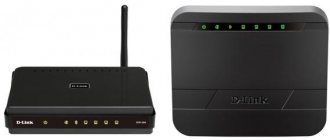Wired connection
Wired access is considered the most reliable and stable, and at the same time the least expensive. Just plug the cable into the connector on your laptop and make simple settings. Several technologies are used: optical cable and ADSL operating via telephone.
Cable
There are also several types of Internet connection. Each of them has slightly different settings.
Dynamic and static IP address
With a static IP, you need to enter the IP address, as well as the subnet mask, gateway and DNS server into the network card settings manually. With dynamic IP, all data is assigned by the operator, and you do not need to make additional settings.
A yellow sign should light up at the bottom of the screen when the cable is connected. Right-click and go to Network and Sharing Center - Change adapter settings. You will see an icon that says Ethernet or Local Area Network. Double click on the icon - Internet version 4 - Properties.
If the operator provides a dynamic address, specify automatic IP and DNS acquisition. When static, enter all the data specified in the contract. Click OK. Now the Internet will work and the yellow exclamation mark will disappear.
PPPoE
With this type, you only need to know your login and password. In the Network Control Center, click on Create and configure a new connection - Internet connection - High-speed (with PPPoE). Type the username and password from the service agreement and come up with a name. If you enter all the data correctly, the connection will be established in a couple of seconds.
Subsequently, to connect, click on the network icon at the bottom of the screen and click “High-speed connection”. When using Windows 10, you will be redirected to the Dialer menu, where you can connect, change or delete the connection.
VPN over L2TP/PPTP
Some providers, for example, Beeline, connect their subscribers using VPN technology using the L2TP or PPTP standard. In the menu for creating a new connection, select Connect to a workplace - Use my Internet connection - Internet address, enter the data from the contract. Come up with a name, for example, the name of the provider, and click “Create”.
Now go to the menu for changing adapter parameters. Right-click on the name of your connection (the adapter will be called WAN miniport) - Properties - in “VPN Type” select the parameters recommended by the provider. We will connect from the networks menu by clicking on the name. If you have Windows 10, you will be redirected to the connection menu.
ADSL modem
ADSL access is not so popular. The signal comes from the telephone line, while the phone itself continues to work as usual. Connect the phone and modem to the splitter, which distributes the signal from the line, the modem with the second connector to the laptop, and then configure the connection on the computer. The procedure is no different from cable Internet.
The service provider will indicate the connection through which they provide wired Internet. Most often this is static IP or PPPoE. Use the previous paragraph to configure the modem.
How to connect the Internet via cable: method No. 1
The connection itself does not require any special skills; even a beginner can handle it. If you need both Wi-Fi and any device connected via cable in your house, then this method will suit you.
Almost any router comes with an Internet cable with RG 45 connectors at both ends.
One end must be plugged into any free LAN connector in the router. Depending on the model, there may be several such connectors; through which one the connection is made is not so important. The second end must be inserted into the network card of the PC (or laptop). The twisted pair cable, which is supplied by the provider when a new subscriber connects, is inserted into the WAN connector of the router. On any device with wi-fi on board, there are indicator lights that show which connector is connected. If you did everything correctly, the lights will light up (usually green).
Wireless connection
To get wireless access, you need to purchase a Wi-Fi router. Plug it into a power outlet, plug the Internet cable into the designated connector (it always differs in color). Next, enter the settings interface via Wi-Fi or cable. Information about login parameters is indicated on the router itself or in its instructions. Enter the IP address, login and password.
When you first connect, you will be prompted for a quick setup. Select your city and provider name and enter your connection details. If your provider is not in the list, check with them for the type of connection, select it in the network settings, enter the data, save and connect.
On your laptop, check for drivers for the Wi-Fi wireless module. This can be done through Device Manager. If the module works correctly, its name will be displayed in full. If the drivers are missing or installed incorrectly, there will be a yellow exclamation mark next to the name “Wireless Adapter”. You will need to download the driver for the Wi-Fi wireless module from the laptop manufacturer's website.
The Wi-Fi adapter must be turned on; it can be activated by pressing the key combination FN + F1–F12. More details can be found in the instructions for the laptop. In the right corner of the bottom of the screen you will see an Internet icon in the form of an antenna with a yellow star. Click on it, select your wireless network from the available connections, enter the password and click “Connect”.
Setting up the router
If your provider uses a dynamic IP address, then when you connect the cable from the provider to the WAN port, the Internet should appear immediately. On the other hand, you should still go into the router settings and change at least the network name and Wi-Fi password.
ATTENTION! If you want to connect a 3G/4G modem to the router, then see the instructions here.
For other types of connections, you also need to go to the device settings and enter some data from the contract. For setup, you can read the general instructions or look at specific models:
- ZyXEL Keenetic
- ASUS
- Linksys
- TR-Link
- D-Link
- Netis
- Tenda
The exact name of your router can be found on the same piece of paper, which is located on the bottom of the device.
mobile connection
When you do not have the opportunity to connect to a landline Internet, you can take advantage of the offer of mobile operators. The quality of these services is at a high level. In many cities, access speed is equal to home Internet. You can connect via a 3G modem, a mobile 3G router, and also use your phone as an access point.
3G modem
It looks like a flash drive into which a SIM card is inserted. When you connect for the first time, the system launches a program to set up the connection. If you purchased a modem from an operator’s official communication store, it will have a proprietary look and settings for working on the network of that particular company. With rare exceptions, you will not have to manually configure the settings. You will need to select a tariff, use the menu to activate the SIM card and the balance on it and connect. Subsequently, it will be enough to insert the modem into the laptop and click the “Connect” button in the program menu.
3G router
In terms of functionality, this is an ordinary router, but instead of a cable, a SIM card is inserted into it. Considering that most models have a built-in battery, you can distribute mobile Internet via Wi-Fi without being tied to a power cord. After inserting the SIM card, carry out the setup procedure as a regular router via the web interface.
Phone as access point
Another simple option is to use an Android or iOS phone as a modem. Just activate the item in the menu. You can read more about this method in our article “How to connect your tablet to the Internet.” However, please note that the phone's battery depletes very quickly. Therefore, it is advisable to connect it to a power source or connect it via USB.
Adapter for laptop to connect to the Internet
A network card is an additional device that allows the computer to interact with devices that distribute the Internet from the provider. The main purpose of a network card is to connect computer devices with each other.
What are the differences between 3G and 4G networks: features, advantages and disadvantages
During production, with the exception of outdated models, laptops are equipped with a network adapter. This makes it possible to connect to the Internet without purchasing a separate part. For laptops that do not have a built-in wireless adapter, there are external adapters that connect via USB or another device port.
How to connect an old laptop without a network card, or the device does not support the new network standard? If the network card does not work, then an external adapter can completely replace it.
Note! There are many external compact adapters on the market that connect via USB, and they are perfect for laptops.
Windows 8
The following sequential steps must be performed:
- Log in to the “Control Panel”;
- Go to the “Network and Internet” section;
- Next, open “Network and Sharing Center”;
- Set o;
- Specify the “Internet Connection” section, click “Next”;
- Then it is recommended to install “High-speed (with PPPoE)”;
- Print the name and access code specified in the agreement with the service provider;
- Click “Connect”.
What to do if the Internet does not appear
No connection? There is no clear solution; there are several possible ways to solve the problem:
- Diagnose network problems. Go to network devices and start the process.
- If the diagnostics do not help, reset the TCP IP settings. Try running the command prompt as an administrator and run the commands in this order: netsh winsock reset; netsh int ip reset. Reboot.
- Sometimes you need to remove network connection drivers. It's not difficult, although it sounds scary. Go to Device Manager and click on the network card. Right-click to select “remove device”. The next time you start the operating system, the latest version of the driver from the existing database will be restored automatically. This method will help prevent network equipment from coming into conflict with software.
Connecting via cable is always easier and faster than wirelessly, and signal reliability is significantly improved. Therefore, you must know how to do it quickly and correctly.
Preliminary activities
But if the user has a question about how to connect the Internet to a laptop, then first they need to decide on the choice of provider. To do this, it is recommended to analyze the following conditions:
- Possibility of cable connection to the system of the communication service provider;
- Price for services provided;
- Providing by the provider a data transfer speed that is acceptable to the subscriber’s requirements at an optimal cost;
- Availability and speed of response of the provider’s technical support service;
- Additional criteria (promotions, special discounts, etc.).
Next, in order to connect to the wired Internet, you need to fill out an application on the official resource of the selected provider or by phone. Also, if possible, it is recommended to simply personally visit a nearby office of the communication service provider to draw up an agreement.
How to connect a laptop without a LAN port to the Internet via cable?
As I already wrote, there are special adapters. More precisely, individual devices are external network adapters with a USB interface. This is an ordinary network card, which is hidden in a small case, and which connects to a laptop into a USB port. Some laptop manufacturers include such adapters in the laptop kit for their models that are not equipped with a built-in network card. These adapters look like this:
I have already talked about one of these devices - TP-LINK UE300. This is a Gigabit USB LAN adapter from TP-Link with USB 3.0 support. Works with any laptops. Including MacBooks.
There are a lot of these devices on the market. Both Chinese nonames for a few dollars, and high-quality and beautiful devices from popular manufacturers of network and computer equipment. There are models with a USB Type-C connection interface. Which is very important, since manufacturers are abandoning not only LAN ports, but also the usual USB Type-A.
How to choose a network adapter for a laptop?
Main characteristics:
- Standard (connection speed). Fast Ethernet is the most affordable adapters. Speeds up to 100 Mbps (10/100 Mbps) are supported. Gigabit Ethernet – connection speed up to 1000 Mbit/s. If you have a router with gigabit ports, then it is better to take a gigabit adapter (Gigabit Ethernet). If possible, you can take such an adapter with a reserve for the future.
- Connection interface. If we are talking about laptops, then there are 2 of them: USB Type-A (regular USB) and USB Type-C (new).
- Additional connectors. There are network adapters with only one connector, for a network cable (above in the photo on the left). And there are models with additional connectors. Most often this is USB (above in the photo on the right).
I wouldn't recommend going with the cheapest adapters if you plan to use them frequently. It is unlikely that they will work for a long time and stably, and produce decent speed. That's all.
How to connect, configure and use?
Everything is as simple as possible. All you need to do is plug the Ethernet adapter into the USB port of your laptop. In most cases, the system will automatically recognize the device and install drivers. There should definitely be no problems in Windows 10. Unless the adapter is some old one.
Even if Windows cannot install drivers automatically, they can be installed either from a disk (which is included, but not always) or from the manufacturer’s website. As a last resort, you can find the driver by hardware ID. I wrote about this in the article which driver is needed for a network card (Ethernet controller).
After the driver is installed and the adapter appears in the device manager, you can connect a network cable from the router, or directly from the Internet provider, to the adapter.
Further work and configuration (if necessary) is no different from a desktop computer or laptop with a built-in network card.
Using an adapter is not as convenient as simply connecting a network cable to the LAN port on a laptop, but in this situation (when the laptop does not have a connector for an Internet cable), you can connect to the Internet either via Wi-Fi or through an external network adapter.
Windows XP
In the case when a user solves the problem of how to connect a laptop to the Internet on which good old Windows XP is installed, then only a few steps should be taken:
- Through “Start” open “Control Panel”;
- Next, go to the “Network Connections” section;
- Then right-click on “Local Network Connection”, click on the “Properties” line;
- Click once on the line “Internet Protocol (TCP/IP)” and then click “Properties”;
- Next, in the window that appears, indicate the data specified in the subscriber’s agreement with the provider;
- Ready! Internet configured.
Alternative to cable Internet
I can’t help but mention another great option - Mobile Internet 4G/LTE. This is an excellent alternative to cable connection in large cities, where 4G network coverage is, if not excellent, then close to it. So, in our city on Megafon I was able to “overclock” to 150 Mbit/s, and this, you see, is an excellent indicator!
In this case, you can connect to the Internet without a router using a USB modem, which is connected to the appropriate port of your computer or laptop. A big plus is that you don’t need to pull the cable and there is no connection to your location. By the way, many modern 4G modems can also work as a router, distributing WiFi.
PS: As you can see, when connecting to the Internet, you can do without a router if necessary. Another point is that now a simple Wi-Fi router like D-Link DIR-300 can be bought on Avito or Yula for almost a symbolic price of 200-300 rubles. It won't cost you much money, but you'll have a lot of fun! The decision is yours!
How to set up wireless Internet access
Those who use a computer a lot and often know how different Windows 7 is from 10, and even more so from XP. Therefore, let's figure out how you can connect and configure a wireless network on a laptop, depending on the OS that is installed on it. 7 remains one of the most popular operating systems. Let's start with it.
Windows 7
You can connect a wireless network on a Windows 7 laptop as follows:
- You should start by checking the Wi-Fi driver. This will allow you to understand whether it is installed and how correctly it works in order to avoid connection difficulties. To do this, go to the “Control Panel” and select the “Hardware and Sound” section;
- Find "Device Manager" and go to it.
- In the list, find the “Network adapters” subsection. There should be WI-FI, Ethernet and Wireless inscriptions here. The latter means the presence of drivers. If it is not there, then you need to install them by downloading from the Internet or from disk. If there is an inscription, but the exclamation mark is lit, then you should click “Enable”;
- If everything is in order with the drivers, then you can proceed to enable the built-in adapter. To do this, open the “Control Panel” and go to the “Network and Internet” section;
- Then go to Network Connections and right-click on Wireless Connection. All that remains is to select “Enable”;
- Connection setup. Before you start using the network, you will have to configure it. To do this, go to “Network and Sharing Center” (in the “Network and Internet” section). There, find the item “Change adapter settings”;
- Right-click on your wireless connection and select Properties.
- Find the item “IP version 4” and click on “Properties”.
- Then all that remains is to either select automatic completion or manually fill in the fields;
- And finally, the most important thing is connection. Find the Wi-Fi icon on the desktop and open it. You should go to your home access point and click “Connect”. Enter your password. A successful connection to the laptop's wireless network will be reflected in a modified shortcut.
With all other operating systems, the principle of how to connect a laptop to wifi (it doesn’t matter if you have Windows XP, 8 or 10) will be the same. Only the names of the items will be slightly different.
XP
We recommend starting setup the same way as on 7 by checking drivers and setting up adapters. You can always find detailed instructions above. If you have successfully completed these steps, you should try connecting via the tray icon. If connecting the laptop to the Internet via wifi failed, then go the following way:
- Open “Control Panel” through “Start” and find the “Network Connections” section.
- Find your wireless connection in the list and right-click to bring up the context menu. Click on "Property".
- In the “wireless networks” tab and click the button with the same name.
- Then click on “Update” and wait for the full list of networks to appear. After that, try to connect.
Windows 8
You can connect to the Internet via wifi on a laptop with Windows 8 if the device has a built-in Wi-Fi module and all the necessary drivers are installed. You can check this by right-clicking on “Start”, then “Task Manager”, “Network Adapters”.
If items in this list are not marked with a question mark or exclamation mark, then everything is in order. Otherwise, you need to update the drivers or download them.
Next you need to set up the Internet on the laptop via wifi, that is:
- move the cursor to the right side of the screen, in the upper corner, a menu with large icons will open;
- find “Settings” among them, then click the icon with the image of a Wi-Fi antenna;
- Click on it and a small “Networks” menu will open. Here you need to turn on the “Wireless Network” slider, select your access point, click “Connection”, enter the password.
Windows 10
To connect Wi-Fi on a Windows 10 laptop:
- Find the connection management window in the tray in the form of an icon with a computer and an antenna;
- The “Network Settings” menu will open;
- Click on the name of your access point and enter your password.
Possible difficulties:
- Can't set up the Internet on your laptop via WiFi? Check for driver updates and their functionality. To do this, go to the “Control Panel” in the “Devices” section;
- On the right side of the screen, select “Device Manager”;
- In the list of drivers, find the item “Network adapters” and expand it. The name of the wireless adapter must contain the word Wireless. If you right-click on it, you will see whether it is possible to update it. If there is no driver, you should download and install it.
- If there is no button to connect to Wi-Fi, you will have to dig into the settings. To do this, go to “Network and Sharing Center”;
- Then click on “Change adapter settings”;
- Right-click on the “Wireless Network Connection” shortcut and click “Enable”.











